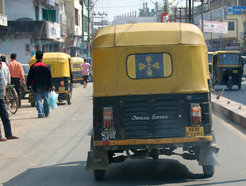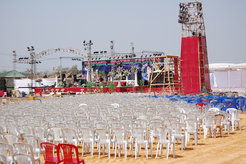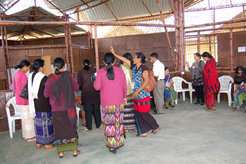An anthropologist among believers
by Vibha Joshi
Are you a Christian? No! How do you expect to understand what we are doing here, if you do not have faith? I was confronted with a series of questions when I walked in to the personal prayer centre that was part of the larger healing prayer meeting being held in Dimapur, Nagaland in February 2011. This interrogation was also the result of my decision on that particular day to go unaccompanied to the place where the three day –prayer and healing service event was being led by the South Indian Charismatic evangelist, Paul Dhinakaran and his young son and apprentice.

The event had been sponsored by the Nagaland Baptist Churches Council. I was supposed to go to the evening prayer meeting with the daughter of the Director of the Nagaland Baptist Churches Peace Council, but she had to cancel it due to some other work. Having kept the day free for the event I thought I would take a chance and go on my own to see what was happening at the venue during the daytime. I caught an auto-riksha (a three wheeler), a popular mode of transport in Dimapur, negotiated the price as the venue was at the outskirts of the town.

When I reached I was told that the main meeting will be held in the evening and could see a large stage and several rows of empty chairs (a day later I would see the crowds in thousands thronging the venue). Then I saw the banner for prayer meetings and a few people moving in and out of a large hall building. I decided to go inside and saw several small groups. Some people were sitting on chairs holding a child and a few men and women holding the Bible in their hands were praying loudly around them.

These were the special healing prayers that were being conducted by prayer group volunteers. I asked one of the volunteers whether it was all right to take some random photographs and tape the prayers of one of the groups. While I was doing so I saw that a lady was gesturing me to come over to a table. At this point I realized I had challenged, as far as Nagaland is concerned, the expectation of ethnographic entry point by going there unaccompanied by a member of their community. I went over to her, and she asked me who I was? Whether I was a journalist? And where had I come from? I explained to her my purpose and she said she was wary of journalist types coming over and then writing about prayer meetings in a degrading skeptical manner. I assured her that that was not my intention and that I was interested in Christianity and the kinds of healing services the church provided. The lady was not quite convinced, and of course she saw before her an Indian (as I am Indian and not Naga [1] , physically different and with a demeanor not of someone who had come to partake in the healing). There were other non-Naga people who were there from Dimapur itself and from the neighbouring state of Assam and I too was definitely an outsider. We began talking and I told her more about myself. It was at this juncture that she asked how, as a non-Christian, I proposed to understand the Christian prayer and concept of healing.
It made me ponder. As an anthropologist this brings into high relief the fundamental question regarding belief , believers and epistemology. What constitutes knowledge, what constitutes research . But it brings up other issues such as whether I have to be a Naga to study Naga people? Do I have to be a Christian to study Christianity among a people? What will I miss out ? Is my study an objective account or subjective? We may think that we have left behind such debates decades ago but then, confronted with a straightforward question, we are made to reconsider how best to answer such a query. Do I start with an outline of what my subject means? what is my methodology? How should I explain to the lady how anthropologists go about their research and to convince her that I am not here to pass judgments on a people’s beliefs. I decided to explain to the lady my research interests, starting from my doctoral research and present post-doctoral work on global networks of Christianity, peace and reconciliation efforts began by the Church, and the Nagaland Missions Movement. I explained that I had met some of the church leaders the day before. We had a long conversation in which she answered several questions about the prayer meeting, the paper prayer request slips that were being filled up by those coming to the prayer hall. She told me about the vigil and chain of prayer that had been undertaken by Baptist churches all over Nagaland in the run up to the three day praying festival. The lady told me that she asked me the question as she herself had studied theology and had an M.Phil. and wondered how a non-theologist and non-Christian could even begin to understand what it means to have full faith and to believe in the healing power of God. Just then another lady joined us. I was introduced to her and it turned out that I had met her husband who was the director of the Nagaland Missions Movement the previous day. Just as this was going on the first lady noticed that I wore hearing aids. She began to sympathise but I politely said they work well which was as well because the operations for my condition had been unsuccessful. She said that they would pray for my well being but that I had to surrender myself totally to the faith. She looked at me, saying faith can heal all to which I had to reply that I was too rational to accept that claim for my particular impairment, but that I was happy for them to pray that my hearing aids should work well during my fieldwork in Nagaland. I replied, “Please do pray but I am unable to do what you are asking of me—I respect your faith and you respect my understanding of the world”. In the end the three prayer group persons put their hands on my head and shoulder and prayed for my well being in English and Nagamese. Before they began I asked if I could record the prayers, but the lady said, ‘no you shouldn’t as it would become part of your research and would lose its meaning’.
After this I took my leave and said I would see them the next day. Next evening I returned with my contact. At the end of the mass prayer meeting we all went to the same prayer hall where several praying sessions were being held simultaneously. The lady I had met on the previous day came to greet us, telling me that I should have come earlier in the evening (I was busy recording the main event then) for I would have seen that ‘miracles had happened, the lame could walk and the blind could see’. She was in effect saying that I had just missed the evidence that my rationality sought. Instead I was invited to go around the prayer hall and take as many photos as I wanted.
---------------------------
[1] The Naga nationalist movement for sovereignty has emphasised the difference.














